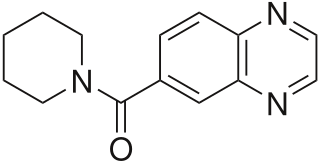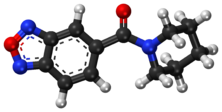
The α-amino-3-hydroxy-5-methyl-4-isoxazolepropionic acid receptor is an ionotropic transmembrane receptor for glutamate (iGluR) that mediates fast synaptic transmission in the central nervous system (CNS). It has been traditionally classified as a non-NMDA-type receptor, along with the kainate receptor. Its name is derived from its ability to be activated by the artificial glutamate analog AMPA. The receptor was first named the "quisqualate receptor" by Watkins and colleagues after a naturally occurring agonist quisqualate and was only later given the label "AMPA receptor" after the selective agonist developed by Tage Honore and colleagues at the Royal Danish School of Pharmacy in Copenhagen. The GRIA2-encoded AMPA receptor ligand binding core was the first glutamate receptor ion channel domain to be crystallized.

Piracetam is a drug marketed as a treatment for myoclonus. It is also used as a cognitive enhancer to improve memory, attention, and learning. Evidence to support its use is unclear, with some studies showing modest benefits in specific populations and others showing minimal or no benefit. Piracetam is sold as a medication in many European countries. Sale of piracetam is not illegal in the United States, although it is not regulated nor approved by the FDA so it is legally sold for research use only.

Ampakines, also stylized as AMPAkines, are a subgroup of AMPA receptor positive allosteric modulators with a benzamide or closely related chemical structure. They are also known as "CX compounds". Ampakines take their name from the AMPA receptor (AMPAR), a type of ionotropic glutamate receptor with which the ampakines interact and act as positive allosteric modulators (PAMs) of. Although all ampakines are AMPAR PAMs, not all AMPAR PAMs are ampakines.

CX717 is an ampakine compound created by Christopher Marrs and Gary Rogers in 1996 at Cortex Pharmaceuticals. It affects the neurotransmitter glutamate, with trials showing the drug improves cognitive functioning and memory.

An analeptic, in medicine, is a central nervous system stimulant. The term "analeptic" typically refers to respiratory analeptics. Analeptics are central nervous system (CNS) stimulants that include a wide variety of medications used to treat depression, attention deficit hyperactivity disorder (ADHD), and respiratory depression. Analeptics can also be used as convulsants, with low doses causing patients to experience heightened awareness, restlessness, and rapid breathing. The primary medical use of these drugs is as an anesthetic recovery tool or to treat emergency respiratory depression. Other drugs of this category are prethcamide, pentylenetetrazole, and nikethamide. Nikethamide is now withdrawn due to risk of convulsions. Analeptics have recently been used to better understand the treatment of a barbiturate overdose. Through the use of agents, researchers were able to treat obtundation and respiratory depression.

CX-516 is an ampakine and nootropic that acts as an AMPA receptor positive allosteric modulator and had been undergoing development by a collaboration between Cortex, Shire, and Servier. It was studied as a potential treatment for Alzheimer's disease under the brand name Ampalex, and was also being examined as a treatment for ADHD.

Latrepirdine is an antihistamine drug which has been used clinically in Russia since 1983.

CX-614 is an ampakine drug developed by Cortex Pharmaceuticals. It has been investigated for its effect on AMPA receptors.

CX-546 is an ampakine drug developed by Cortex Pharmaceuticals.

LY-503430 is an AMPA receptor positive allosteric modulator developed by Eli Lilly.

Ispronicline is an experimental drug which acts as a partial agonist at neural nicotinic acetylcholine receptors. It progressed to phase II clinical trials for the treatment of dementia and Alzheimer's disease, but is no longer under development.

Perampanel, sold under the brand name Fycompa, is an anti-epileptic medication developed by Eisai Co. that is used in addition to other drugs to treat partial seizures and generalized tonic-clonic seizures for people older than twelve years. It was first approved in 2012, and as of 2016, its optimal role in the treatment of epilepsy relative to other drugs was not clear. It was the first antiepileptic drug in the class of selective non-competitive antagonist of AMPA receptors.

Sunifiram is an experimental drug which has antiamnesic effects in animal studies and with significantly higher potency than piracetam. Sunifiram is a molecular simplification of unifiram (DM-232). Another analogue is sapunifiram (MN-19). As of 2016, sunifiram had not been subjected to toxicology testing, nor to any human clinical trials, and is not approved for use anywhere in the world.

Unifiram is an experimental drug. that has antiamnesic and other effects in animal studies with far greater potency than piracetam. A number of related compounds are known, such as sunifiram (DM-235) and sapunifiram (MN-19). Unifiram has two enantiomers, with the dextro form being the more active isomer. It has been shown to reduce the duration of hypnosis induced by pentobarbital, without impairing motor coordination. As of 2015, no formal human studies with unifiram have been conducted. Unifiram is not patented and, despite the lack of human and long-term toxicity studies, it is commonly sold online.

ORG-26576 is an ampakine originally developed by Cortex Pharmaceuticals and then licensed to Organon International for development. In animal studies it has been shown to effectively potentiate AMPA receptor function, leading to increased BDNF release and enhanced neuronal differentiation and survival, as well as producing nootropic effects in standardised assays. Development as an antidepressant has been halted due to a failed Phase II trial for major depressive disorder.

Pesampator is a positive allosteric modulator (PAM) of the AMPA receptor (AMPAR), an ionotropic glutamate receptor, which is under development by Pfizer for the treatment of cognitive symptoms in schizophrenia. It was also under development for the treatment of age-related sensorineural hearing loss, but development for this indication was terminated due to insufficient effectiveness. As of July 2018, pesampator is in phase II clinical trials for cognitive symptoms in schizophrenia.

Mibampator is a positive allosteric modulator (PAM) of the AMPA receptor (AMPAR), an ionotropic glutamate receptor, which was under development by Eli Lilly for the treatment of agitation/aggression in Alzheimer's disease but was never marketed. It reached phase II clinical trials prior to the discontinuation of its development.

Tulrampator is a positive allosteric modulator (PAM) of the AMPA receptor (AMPAR), an ionotropic glutamate receptor, which is under development by RespireRx Pharmaceuticals and Servier for the treatment of major depressive disorder, Alzheimer's disease, dementia, and mild cognitive impairment. Tulrampator was in phase II clinical trial for depression, but failed to show superiority over placebo. There are also phase II clinical trials for Alzheimer's disease and phase I trials for dementia and mild cognitive impairment.

AMPA receptor positive allosteric modulators are positive allosteric modulators (PAMs) of the AMPA receptor (AMPR), a type of ionotropic glutamate receptor which mediates most fast synaptic neurotransmission in the central nervous system.

Willardiine or (S)-1-(2-amino-2-carboxyethyl)pyrimidine-2,4-dione is a chemical compound that occurs naturally in the seeds of Mariosousa willardiana and Acacia sensu lato. The seedlings of these plants contain enzymes capable of complex chemical substitutions that result in the formation of free amino acids. Willardiine is frequently studied for its function in higher level plants. Additionally, many derivates of willardiine are researched for their potential in pharmaceutical development. Willardiine was first discovered in 1959 by R. Gmelin, when he isolated several free, non-protein amino acids from Acacia willardiana when he was studying how these families of plants synthesize uracilyalanines. A related compound, Isowillardiine, was concurrently isolated by a different group, and it was discovered that the two compounds had different structural and functional properties. Subsequent research on willardiine has focused on the functional significance of different substitutions at the nitrogen group and the development of analogs of willardiine with different pharmacokinetic properties. In general, Willardiine is the one of the first compounds studied in which slight changes to molecular structure result in compounds with significantly different pharmacokinetic properties.



















